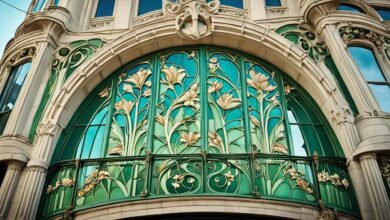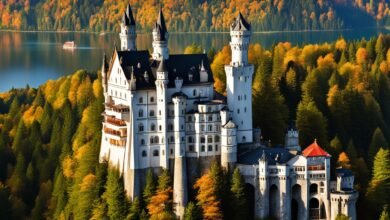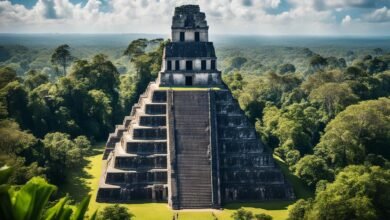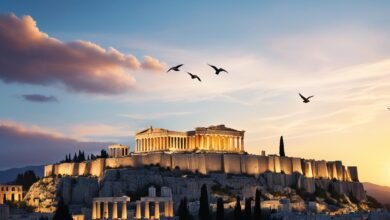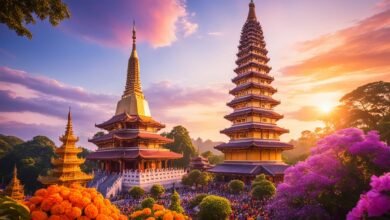Table of Contents
Imagine being in a very old Buddhist temple, surrounded by nature. You feel peaceful and spiritual. The wind moves the leaves, bringing smells of incense and history. When you look, Seiganto-ji Temple stands before you. It is located in Wakayama Prefecture, Japan.
Feel the calmness as you enter this holy place. Ancient traditions meet stunning architecture here. Known as the “Temple of Crossing the Blue Shores,” Seiganto-ji connects you with Japan’s spiritual past. It invites you to discover its deep roots.
Walking through the temple, its long history fascinates you. Seiganto-ji is over a thousand years old. It is the first stop on the Saigoku Kannon 33 Pilgrimage. This place is part of the Tendai-Sanmon sect. It stands out as a UNESCO World Heritage Site and an Important Cultural Property of Japan.
The charm of Seiganto-ji is not just in its past. It’s located in the scenic Kumano region, close to legends and the stunning Nachi Falls. The Sanjūdō Pagoda offers amazing views. Cherry tree-lined paths lead to Nachi waterfall. There, you see nature’s raw beauty.
The Sanjūdō Pagoda and Nachi Falls
The Sanjūdō Pagoda at Seiganto-ji is a top spot to see. It was built in 1971, taking the place of an older pagoda. Now, it gives visitors an amazing view of the area. Inside, there’s a prized image of Senjū Kannon and more.
A stone path from the pagoda heads to the Nachi waterfall. It goes through cherry trees and past an old temple site. Here is where the famous Nachi fire festival is held.
The Sanjūdō Pagoda is a stunning part of Seiganto-ji. It lets people see the Nachi Falls up close. The pagoda’s modern build lets everyone dive into the history and beauty of the place.
Discover the Nachi Falls
The Nachi Falls, or Nachi-no-taki, is Japan’s tallest waterfall that flows without stopping. It falls from 133 meters and is a key part of Seiganto-ji’s spiritual feel.
Green trees and mist surround the Nachi Falls. This spot shows off nature’s strength and beauty. It’s home to Hiro Gongen, a Shinto god. Senjū Kannon is also here, adding to the falls’ spiritual touch.
Walking from the pagoda to the falls is special. In spring, cherry blossoms make the path even more beautiful. This route highlights the magical feel of Seiganto-ji and its surroundings.
“The Sanjūdō Pagoda offers a unique view of the Kumano area. The Nachi Falls amaze with their beauty. This blend of nature and spirit makes Seiganto-ji unforgettable.” – A visitor
The Nachi fire festival is a must-see at Seiganto-ji. It happens on July 14th each year. The festival lights up the path to the waterfall with fire and rituals. It’s a rare cultural event for visitors.
Image: Sanjūdō Pagoda and Nachi Falls
The Majestic Sanmon Mountain Gate
When you enter the upper temple area of Seiganto-ji, the Sanmon Mountain Gate welcomes you. This bright red gate symbolizes greatness and spiritual journey. It invites you to see more of the temple area.
The gate is an architectural wonder with detailed designs and stunning work. Its tall stature draws your attention. It makes you think about Seiganto-ji’s long history and spiritual importance.
Climbing about 500 stone steps to the temple, you feel deep respect and wonder. Each step brings you closer to the spiritual center of Seiganto-ji.
The gate features the Kongōrikishi guardians, powerful figures that show strength. These guardians were made by the famous Tankei. They act as silent guards, keeping evil away and preserving the temple’s purity.
At the gate’s other end, you meet the fierce Shishi lion-dogs. Their scary faces represent power and control. These legendary creatures protect Seiganto-ji, keeping the temple and its wisdom safe.
Walking through the Sanmon Mountain Gate is more than just entering Seiganto-ji’s space. You start a journey of the soul. The gate offers a path to peace and insight, leading you to the temple’s heart.
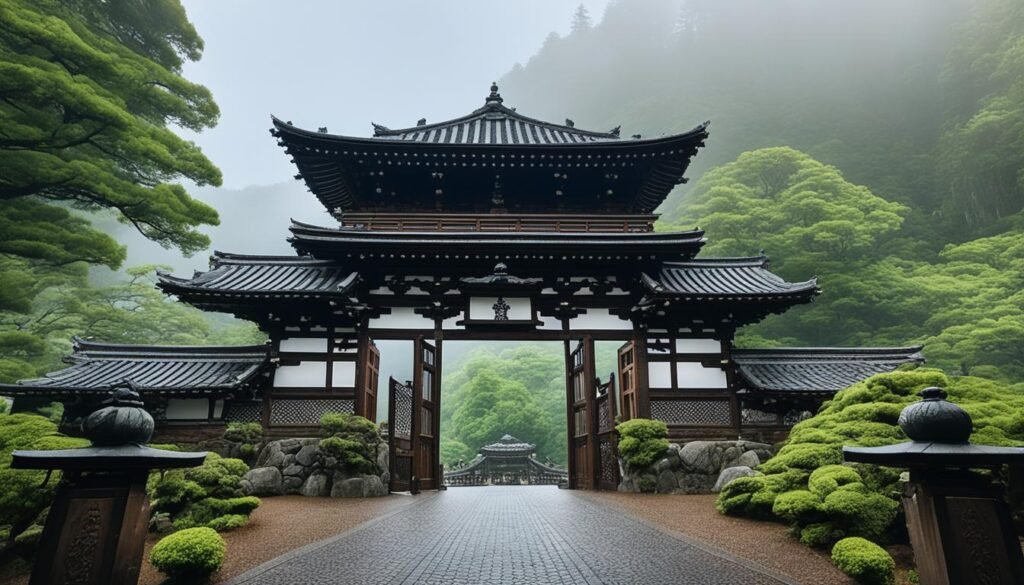
Sanmon Mountain Gate Highlights:
- The vermillion-colored gate with intricate details
- About 500 stone steps leading up to the temple
- Carved Kongōrikishi guardians created by sculptor Tankei
- Striking Shishi lion-dogs at the other side of the gate
The Historic Main Temple
The Nyoirindō, or the Temple of the Wish-fulfilling Kannon, is the main temple of Seiganto-ji. It was rebuilt in 1587 by Toyotomi Hideyoshi, an influential figure in Japanese history. The Nyoirindō shows off Momoyama Era architecture with its unique shingled roof called “irimoya.”
This temple isn’t just a beautiful building. It’s also a significant part of history. Being the oldest building in the southern Kii region, it’s very special in Japanese heritage. The Nyoirindō is recognized as a National Important Cultural Property of Japan. It shows the rich cultural and spiritual traditions of Seiganto-ji.
“The Nyoirindō stands as a testament to the architectural brilliance of the Momoyama Era.”
When you step into the Nyoirindō, its calm atmosphere and beautiful details capture you. Inside, there are beautiful Buddhist statues and sacred relics. They offer a peek into the ancient spiritual practices followed at Seiganto-ji for centuries.
Toyotomi Hideyoshi and the Nyoirindō
The rebuilding of the Nyoirindō by Toyotomi Hideyoshi highlights its historical value. Hideyoshi was a famous warlord and statesman who loved art and culture. His support of the arts greatly influenced Japanese aesthetics during his time.
By rebuilding the Nyoirindō, Hideyoshi not only brought back its beauty. He also emphasized Seiganto-ji’s importance as a religious and cultural center in Japan.
“The reconstruction of the Nyoirindō by Toyotomi Hideyoshi signifies the temple’s historical importance and its role during the Momoyama Era.”
Momoyama Era Architecture at its Finest
The Momoyama Era lasted from the late 16th to the early 17th century. It’s known for its unique architectural style. The Nyoirindō is a prime example of this style, with elegant lines and intricate carvings.
The “irimoya” shingled roof of the Nyoirindō is vibrant and distinctive. Each tile is carefully made to create a beautiful pattern. This shows the amazing craftsmanship of the time.
Visiting the Nyoirindō lets you see the greatness of Momoyama Era architecture yourself. It helps you appreciate its impact on Japanese culture.
“The Nyoirindō exemplifies the elegant lines, intricate carvings, and harmonious balance of Momoyama Era architecture.”
The Waniguchi “Crocodile Mouth” Gong
Toyotomi Hideyoshi donated a large 1.45-meter-wide bronze waniguchi gong to Seiganto-ji during its restoration. Known as the largest in Japan, it carries a prayer for his descendants’ safety and longevity. Visitors enjoy the challenge of ringing it using a special rope flicking technique.
Seeking a unique cultural experience? The Waniguchi Gong at Seiganto-ji is a must-see. Gifted by Toyotomi Hideyoshi, this 1.45-meter-wide bronze gong stands proudly as Japan’s largest. It brings a sense of splendor to the temple.
This gong is more than a historical piece; it plays a key role in mountain traditions. Engraved with prayers for Hideyoshi’s line, it symbolizes deep respect and history. It’s a significant part of Seiganto-ji’s heritage.
Don’t leave Seiganto-ji without ringing the waniguchi gong. Mastering the rope flick might take a try or two, but hearing its deep sound is unforgettable. Feeling its vibrations fill the temple grounds is an awe-inspiring moment.
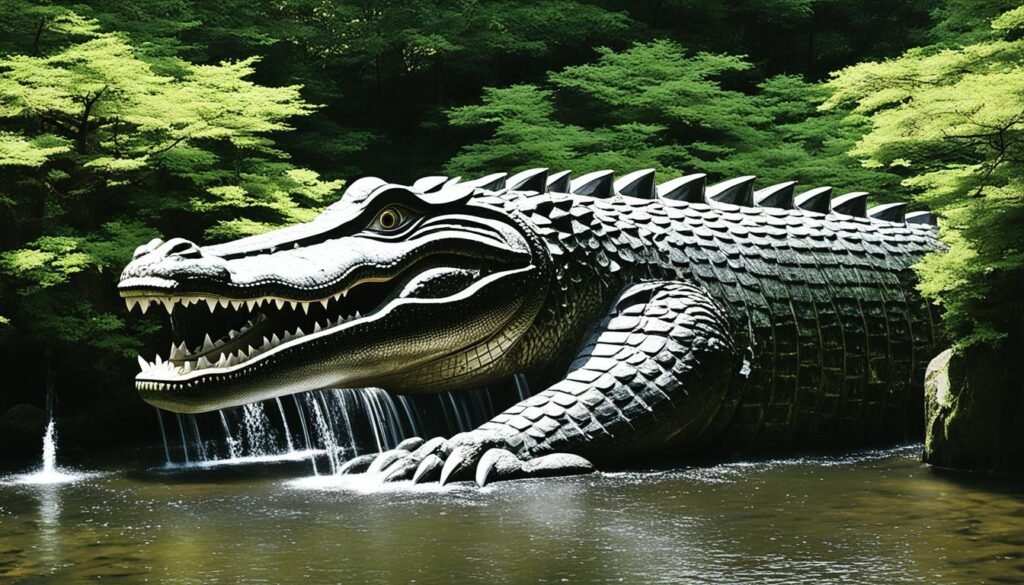
Many have been captivated by the Waniguchi Gong’s magnificence and the traditions it represents. Its historical importance, mesmerizing sound, and cultural value are unforgettable. Visiting the waniguchi gong at Seiganto-ji promises an impactful experience.
The Hall of Lanterns
The Hall of Lanterns, or Nyohōdō, is a magical place in the Seiganto-ji Temple complex. It is dedicated to Daikokuten, a god of wealth and prosperity. As you come closer, you’ll see lots of red paper lanterns. They hang from the roof, shining brightly in the sun or glowing softly at night.
Once inside the Nyohōdō, you enter a world of beauty. There’s an old statue of Daikokuten, easy to spot with his big belly and joyful smile. Surrounded by light from the lanterns, the place feels calm and sacred. It’s perfect for quiet thoughts and reflection.
“The Hall of Lanterns shows the richness and spiritual depth of Seiganto-ji. Visitors can feel the energy of wealth here and ask for blessings of prosperity and luck.”
Dive into the Wisdom of the Seven Lucky Gods
The Hall is dedicated to Daikokuten, one of the Seven Lucky Gods. These gods are symbols of fortune and blessing. They embody different good fortunes, such as wealth and wisdom.
Each Lucky God stands for a kind of prosperity, like wealth or love. They bring blessings that can improve various parts of life.
Below is a table that introduces the Seven Lucky Gods, their attributes, and their symbolic meanings:
| Lucky God | Attributes | Symbolic Meaning |
|---|---|---|
| Ebisu | A fisherman and the god of business and prosperity | Financial success and abundance |
| Daikokuten | Carrying a magic mallet and a bag of treasures | Wealth, good fortune, and fulfillment |
| Fukurokuju | An old man with a prominent forehead and a long white beard | Longevity, wisdom, and good health |
| Benzaiten | A goddess of music and arts playing the biwa, a Japanese lute | Creativity, talent, and harmony |
| Hotei | A lovable, laughing monk with a large belly | Contentment, joy, and a carefree life |
| Jurojin | An old man with a white beard and a staff of wisdom | Longevity, health, and happiness |
| Bishamonten | Clad in armor and wielding a spear | Protection, courage, and victory over adversity |
Learn about the Seven Lucky Gods to understand their roles in bringing prosperity and harmony to life.
Leaving the Hall of Lanterns, think about how Daikokuten and the other gods fit into Japanese culture. Seiganto-ji remains a place full of spiritual wealth and tradition.
Legends and History of Seiganto-ji
Dive into the captivating legends and deep history of Seiganto-ji. This ancient temple is filled with stories handed down over time. They add to its mystical charm and importance.
A famous story is about Ragyō Shōnin, a priest known for his strong faith. After a tough One Hundred Day Waterfall practice, he found a golden Kannon image. This event has made him a permanent part of the temple’s history.
There’s also a legend about Shōbutsu Shōnin, led by Kannon to find treasure. He found a stunning golden Kannon statue buried at Seiganto-ji. This statue still amazes visitors today.
Seiganto-ji has drawn emperors, poets, and other notable people through history. Izumi Shikibu, a famous poetess, visited for inspiration. She wrote sacred poems to Kannon, contributing to the temple’s spiritual ambiance.
The tales of Seiganto-ji remind us of its spiritual significance. Visiting lets you experience a place where fantasy meets reality. You feel a deep sense of wonder and respect for the past and present.
